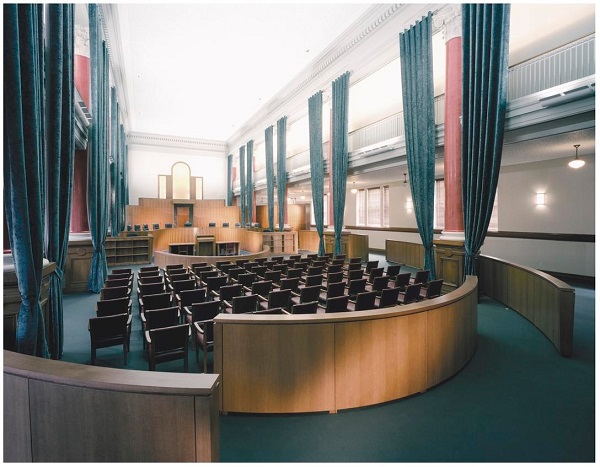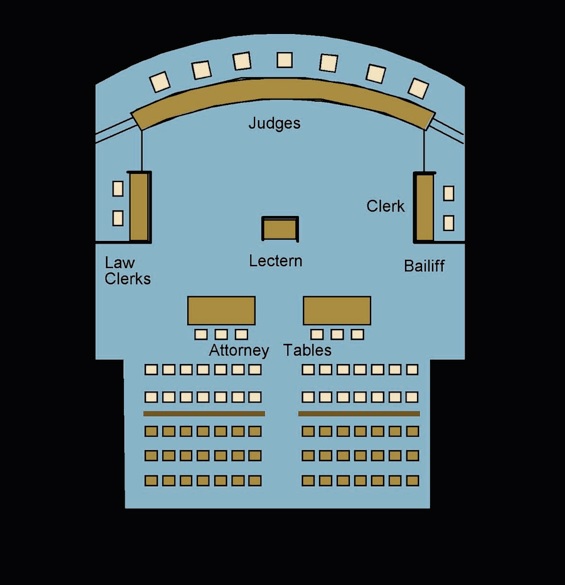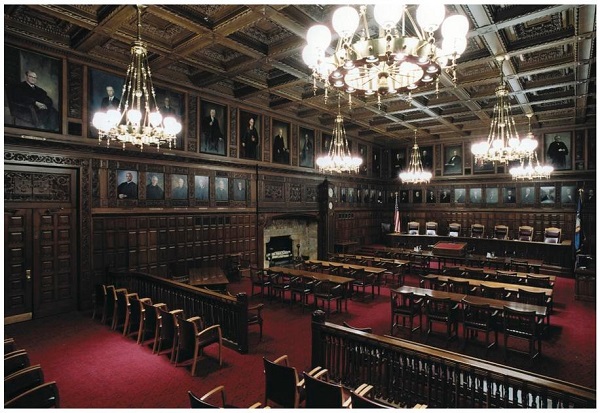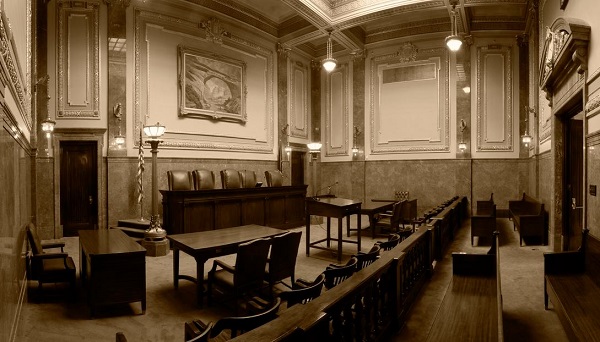 |
|
Connecticut Appellate Courthouse - Courtroom View from Public Entrance |
Appellate courts generally are used infrequently, have few spectators and minimal public traffic. The courtroom is used for hearing oral arguments and conducting ceremonies. Courts of last resort, usually the state's supreme court, generally hear final appeals in civil and criminal matters. They may have jurisdiction in capital cases, administrative agency decisions, lawyer and judicial disciplinary cases, and juvenile and interlocutory matters. Appellate courts do not have juries or witnesses; there are usually five to nine justices who may sit either en banc or in panels of three to hear oral arguments.
 |
|
Appellate Courtroom |
Intermediate appellate courts, referred to as the court of appeals in most states, often have mandatory jurisdiction over original appeals from the trial courts. In some states, the intermediate appellate court hears appeals from some trial courts, or its jurisdiction may be limited to only civil or non-capital criminal cases. Capital cases proceed directly to the court of last resort for automatic review in most states.
In some states, the intermediate appellate court sits in geographic appellate divisions throughout the state. The number of judges ranges from 3 in some states to as many as 92 in Puerto Rico. The court may have its own courthouse, or judges may use trial courtrooms to hear cases.
In addition to the judges' chambers, space needs include offices for research assistants, law clerks, and judicial secretaries; conference areas; court clerk's offices; law library; and attorney-waiting areas.
An example of more detailed appellate court standards may be found in the California Appellate Court Facilities Guidelines, published by the Judicial Council of California, Administrative Office of the Courts, in 2002.
 |
|
New York State Court of Appeals Courtroom |
 |
|
Utah Supreme Court |
A higher level of design is often typical of appellate courtrooms, denoting the superior position of such courts in the judiciary. Furniture should be an integral part of the architecture. A fixed lectern placed between the counsel tables is commonly found in an appellate courtroom.
The space required for a state's court of last resort generally will be greater than for its intermediate appellate court because of the larger bench needed to seat theen banc court and the court's higher status. Seating for an appellate court bench varies depending upon the size of the court. Typically, an appellate court bench seats three or more judges. The size of the public seating will depend upon the ceremonial uses of the courtroom.
Support spaces may include an attorneys' waiting room, judges' conference room, robing room, and law library.
All courtroom participants should be able to hear the proceedings clearly. Within the courtroom, background or ambient sound should be minimized. Certain sounds such as the justices’ statements and those of the attorneys may be enhanced. The courtroom acoustical design should permit the justices to communicate with staff in sidebar conversations without being overheard.
The quality of light should be sufficient to perform tasks required in each space.
The courtroom should have an individual temperature control for the HVAC system. The introduction of adequate fresh air and exhaust ventilation is critical in the courtroom and any other areas subject to dense occupation. Sound transmission and isolation of HVAC equipment and the air distribution system should be addressed to reduce disruptive noise in all areas of the courthouse, especially the courtroom.
All courtroom stations should be accessible to persons with disabilities.
Sufficient circulation space is required behind the bench for the justices to enter and exit. In some courts, conferences are held immediately after oral arguments. This requires a private judicial conference room, with private toilet facilities, adjacent to the judges' entrance to the courtroom.
Where cases are conferenced at a later date, a conference room also should be located near the judges' chambers. Judges also require a robing room immediately adjacent to the courtroom entrance with lockers for storing their robes.
The attorney waiting area, or lobby, should be adjacent to the courtroom.
The courtroom and the clerk's offices are the two areas of an appellate court that need to be easily accessible to the public and attorneys. Both should be conveniently located on the main public corridor and easy to locate from the public entrance.
The courtroom should have a security station. The bench and bailiff station should be equipped with a security alarm monitored by a central security office.
All furnishings should be of an enhanced quality to reflect the prestige and dignity of the court. A higher level of furnishings is generally appropriate for appellate courtrooms. Where an appellate court sits in a trial courtroom, modular furniture that can be assembled rapidly is an option. The bench should have sufficient work surface for taking notes and holding case files.
Court-recording equipment should be integrated with the furniture, and each judge's space should be equipped with a concealed microphone. The bench should have an intercom, or telephone, and clock/timer. The court may wish to consider built-in file cabinets in the conference rooms for storing case files and papers.
The courtroom lectern should have a built-in microphone and task lighting. A display area sufficient for an easel or video display screen may be provided.
Justices and court staff should have access to audiovisual/video equipment, computer terminals or personal computers, and case management systems.
Technology closets should be positioned adjacent to the courtrooms for audio/visual racks and other computer technology.
Plan on the use of laptop or tablet computers for note taking and viewing case-related materials, draft opinions, and digital video court records in the judicial conference room.
